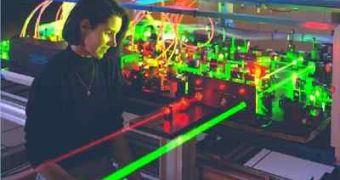Starting with the first half of the 20th century it has been apparent that the Universe is made up of more than just the things we can see. It is now widely accepted that a large fraction of the Universe consists of "dark matter" in the form of a new type of fundamental particle. In astrophysics and cosmology, dark matter is matter of unknown composition that does not emit or reflect enough electromagnetic radiation to be observed directly, but whose presence can be inferred from gravitational effects on visible matter.
According to present observations of structure larger than galaxy-sized as well as Big Bang cosmology, dark matter accounts for the vast majority of mass in the observable universe.
Recently, physicists at the University of Florida and Lawrence Livermore National Laboratory propose a redesign of the experiment called "shining light through walls", currently being attempted in various forms by several groups of physicists worldwide. Although theoretical at the moment, they say their design could make such experiments a billion times more sensitive in their goal of detecting axions.
The axion is a hypothetical elementary particle postulated by Peccei-Quinn theory in 1977, thought to have no electric charge, almost no mass and very low interaction cross-sections for strong and weak forces. Because of their properties, axions interact only minimally with ordinary matter. Axions are predicted to change to and from photons in the presence of strong magnetic fields, and this property is used for creating experiments to detect axions.
Proving its existence would shed light on several different conundrums in particle physics, including the nature of dark matter.
The initial experiment seeks to detect axions by shining a laser down the bore of a powerful superconducting magnet. A wall in the middle stops the laser cold, with the theoretical axions continuing through the wall and into the other side of the magnet. There, the magnet reconverts them into photons, or particles of light.
Sikivie, UF physics professor David Tanner and Karl van Bibber, a physicist at the Lawrence Livermore National Laboratory, propose a redesign of the "shining light through walls" experiment to make it, in their words, "vastly more sensitive."
In a nutshell, they suggest placing pairs of highly reflective mirrors called Fabry-Perots cavities on both sides of the wall. The cavity on the laser light side of the wall would cause the light to bounce back and forth repeatedly, as though in an echo chamber. This action would produce many more of the hypothesized axions than a single beam of light, making them easier to detect on the other side of the wall.
"What happens is, because the light goes back and forth many times as it goes through the magnet, it produces more axions," Sikivie said.
The Fabry-Perot cavity on the other side of the wall would perform a similar function, producing even more photons from the added axions.
Sikivie said researchers are doing separate applications to detect axions produced by the sun, which would seem to be an easier approach because the sun is a much more powerful source than any laser. But the modified experiment would at least in theory have a higher sensitivity than these solar-based experiments.
"With these two cavities on both sides, it actually gets better, by a factor of 10 maybe, than the solar axion experiments," he said.
Although dark matter was detected in space by its gravitational lensing in August 2006, direct observation of these dark matter particles has never yet been made, but the experiment is hoped to catch a glimpse of these exotic particles, so far only theorized.

 14 DAY TRIAL //
14 DAY TRIAL //